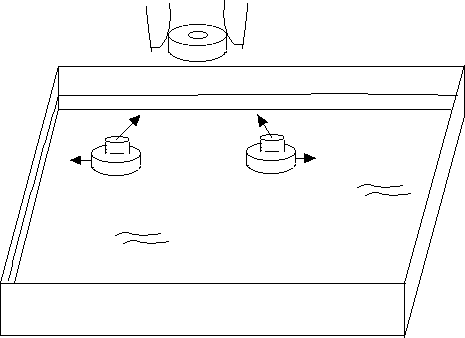
Hold a magnet over the floating magnets so that it attracts the floaters which in turn repel each other.
Floating magnets arrange themselves in interesting geometric patterns.
Introduction
Small magnets floating on water can be made to repel each other and to attract another magnet the resulting balance of attraction and repulsion creates geometrical patterns.
Material
Optional construction
Assembly
Arrange the magnets into one stack.
Carefully remove the magnets from the stack keeping the top pole up.
Glue the magnets to the floatation disks, or inside the bottle
caps.
Fill the tray with water.
To Do and Notice
Place two magnets into the tray. (If the magnets
flip over then leave them upside down, this is a more stable position
than having the magnet on top.)
Notice that the magnets repel each other to the far sides of the
tank.
Remove one magnet leaving one in the tank.
Hold the large magnet over the tank (or place it on the piece of
wood).
Orient it so that it attracts the floating magnet.
Notice that the floating magnet moves until it is centered under the
larger magnet.
Put a second magnet into the tank. The two floating magnets repel
each other and are attracted to the larger magnet. They form a
straight line centered on the attracting magnet.

Three magnets form an equilateral triangle.
Move the larger magnet up and down, watch the triangle expand and
contract as the attraction becomes weaker and stronger.
Four make a square.
Five make a pentagon.
Six make either a hexagon or a pentagon with a magnet in the center
depending on the place the sixth magnet is added.
Seven will always from a hexagon with one in the center, the final
pattern may take a while to form.
Continue adding magnets and making predictions.
What’s Going On?
The floating magnets repel each other because they have the same pole oriented up. Yet they are attracted to the larger magnet. The attraction and repulsion results in the creation of geometric patterns. The size of the patterns is determined by the relative strengths of the attraction and repulsion.
Some numbers of magnets have two different stable patterns. Each pattern is a local minimum energy configuration.
Going Further
A variation on this exploration uses a circular dish meant to hold potted plants perhaps 9 inches in diameter surrounded by a set of donut shaped refrigerator magnets 3 cm (1.25") in outer diameter. Orient the donut magnets to repel each other and the floating magnets. For a 9 inch tray use 10 magnets equally spaced around the outside.
Etc
The patterns developed by the floating magnets are like those in crystals.
And for similar reasons. Richard Feynman says of atoms,"they repel each other when close together and attract when at a distance." This same pattern of attraction and repulsion is shown here.
|
Scientific Explorations with Paul Doherty |
|
23June 2000 |